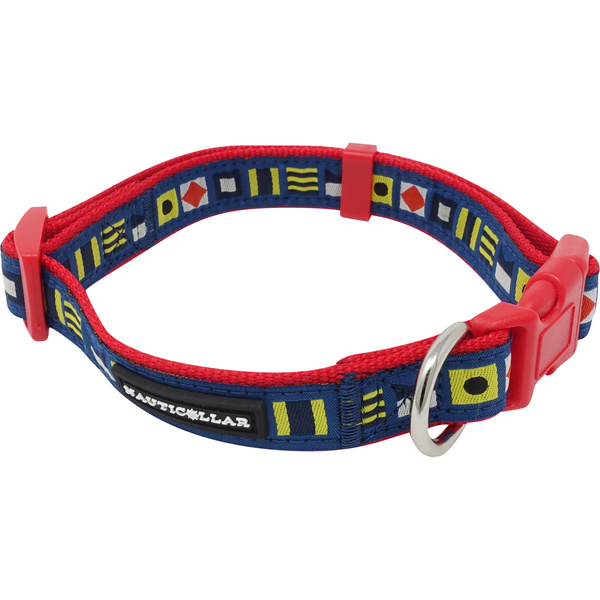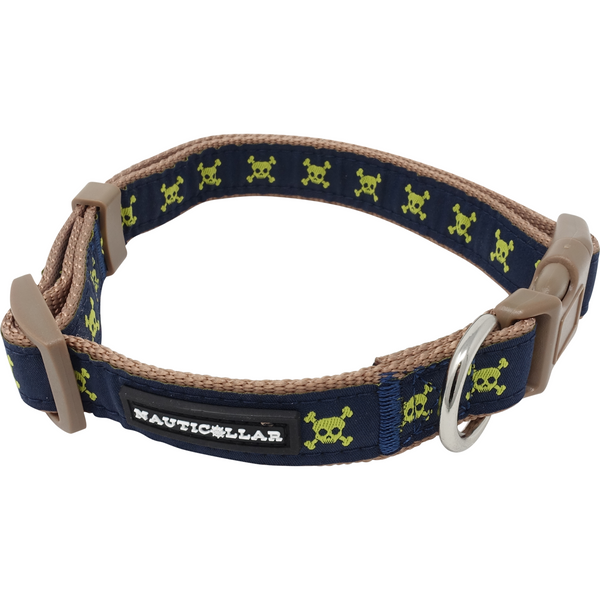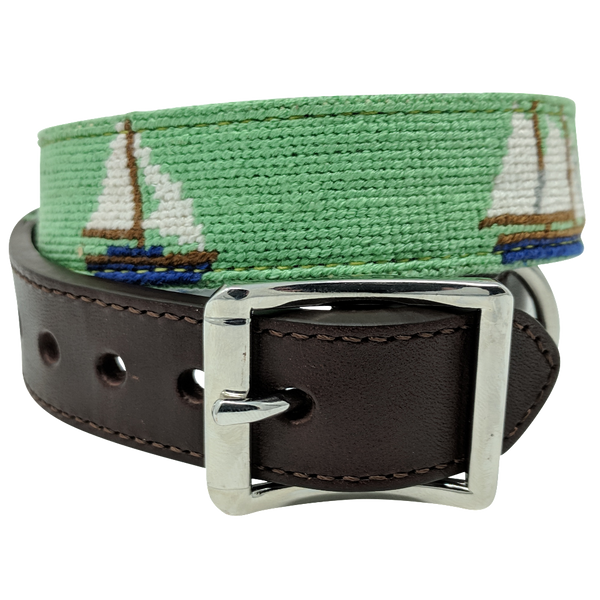Naming your dog is a major decision. You want a name that is unique, but also reflects your dog's unique personality. The Nauticollar team has been working diligently to curate the best nautical dog names for 2021. Let us help you find a name that is as unique as your dog's personality. What is a must-have accessory that goes with every Nauticollar nautical dog collar? A nautical dog name of course! We have compiled a list of our 100 favorite nautical dog names for 2021 (and their nautical definitions):

-
Admiral - Senior naval officer of Flag rank.
-
Ahoy - A cry to draw attention. Term used to hail a boat or a ship, as "Boat ahoy!"
-
Anchor - An object designed to prevent or slow the drift of a ship, attached to the ship by a line or chain; typically a metal, hook-like or plough-like object designed to grip the bottom under the body of water. (Goes great with out Needlepoint Anchor collars: https://nauticollar.com/products/anchor-needlepoint-dog-collar)

-
Ballast - Heavy material that is placed in the hold of a vessel to provide stability.
-
Barge - A towed or self-propelled flat-bottomed boat, built mainly for river, canal, and coastal transport of heavy goods.
-
Barque (or bark) - A sailing vessel of three or more masts, with all masts but the sternmost square-rigged, the sternmost being fore-and-aft-rigged.
-
Barrelman - A sailor that was stationed in the crow's nest.
-
Batten - A stiff strip used to support the roach of a sail, enabling increased sail area.
-
Battleship - A type of large, heavily armored warship of the second half of the 19th century and first half of the 20th century armed with heavy-caliber guns, designed to fight other battleships in a line of battle. It was the successor to the ship-of-the-line of the Age of Sail.
-
Beacon - A lighted or unlighted fixed aid to navigation attached directly to the earth's surface.
-
Beam - The width of a vessel at the widest point, or a point alongside the ship at the midpoint of its length.
-
Bearing - The horizontal direction of a line of sight between two objects on the surface of the earth
-
Berth - A location in a port or harbor used specifically for mooring vessels while not at sea.
-
Binnacle - The stand on which the ship's compass is mounted.
-
Boat - A small craft or vessel designed to float on, and provide transport over, or under, water.
-
Boatwright - A maker of boats, especially of traditional wooden construction.
-
Boom - A spar attached to the foot of a fore-and-aft sail.
-
Boomer - Slang term in the US Navy for a ballistic missile submarine.
-
Bow - The front of a vessel.
-
Brig - A vessel with two square-rigged masts.
-
Bulkhead - An upright wall within the hull of a ship, particularly a watertight, load-bearing wall.
-
Bulwark - The extension of the ship's side above the level of the weather deck.
-
Bunker - A container for storing coal or fuel oil for a ship's engine.
-
Buoy - A floating object of defined shape and color, which is anchored at a given position and serves as an aid to navigation.
-
Captain - The person lawfully in command of a vessel. "Captain" is an informal title of respect given to the commander of a naval vessel regardless of his or her formal rank; aboard a merchant ship, the ship's master is her "captain."
-
Catamaran - A vessel with two hulls.
-
Cleat - A stationary device used to secure a rope aboard a vessel
-
Clipper - A very fast sailing ship of the 19th century that had three or more masts, a square rig, a long, low hull, and a sharply raked stem.
-
Commodore - a military rank used in many navies that is superior to a navy captain, but below a rear admiral. Often equivalent to the rank of "flotilla admiral" or sometimes "counter admiral" in non-English-speaking navies.
-
Compass - Navigational instrument showing the direction of the vessel in relation to the Earth's geographical poles or magnetic poles.
-
Corinthian - An amateur yachter.
-
Corsair - A French privateer, especially from the port of St-Malo.
-
Corvette - A flush-decked sailing warship of the 17th, 18th, and 19th centuries having a single tier of guns, ranked next below a frigate.
-
Crew - On warships and merchant ships, those members of a ship's company who are not officers
-
Cruiser - From the mid-19th century to the mid-20th century, a classification for a wide variety of gun- and sometimes torpedo-armed warships, usually but not always armored, intended for independent scouting, raiding, or commerce protection; some were designed also to provide direct support to a battlefleet.
-
Cutter - A small single-masted boat, fore-and-aft rigged, with two or more headsails and often a bowsprit. The mast is set farther back than on a sloop.
-
Decky - A person whose job involves aiding the deck supervisor in (un)mooring, anchoring, maintenance, and general evolutions on deck.
-
Destroyer - A type of fast and maneuverable small warship introduced in the 1890s to protect capital ships from torpedo boat attack, since increased in size and capabilities to become a long-endurance warship intended to escort larger vessels in a fleet, convoy, or battle group and defend them against submarines, surface ships, aircraft, and missiles.
-
Dinghy - A type of small boat, often carried or towed as a ship's boat by a larger vessel.
-
Dock - A fixed structure attached to shore to which a vessel is secured when in port, generally synonymous with pier and wharf, except that pier tends to refer to structures used for tying up commercial ships and to structures extending from shore for use in fishing, while dock refers more generally to facilities used for tying up ships or boats, including recreational craft.
-
Drifter - A type of fishing boat designed to catch herring in a long drift net, long used in the Netherlands and Great Britain.
-
Fender - A flexible bumper used in boating to keep boats from banging into docks or each other.
-
First mate - The second-in-command of a commercial ship.
-
Flotsam - Debris or cargo that remains afloat after a shipwreck.
-
Frigate - In the 17th century, any warship built for speed and maneuverability.
-
Galley - Galley, the kitchen of a ship.
-
Grog - Watered-down pusser's rum consisting of half a gill with equal part of water, issued to all seamen over twenty.
-
Gunter - A wire that leads from one point near the end of a gaff to a point near the other end; a block travels along the wire and a halyard is attached to the block, allowing the gaff to be raised to the vertical by a single halyard, though another halyard is required at the gaff jaws to control height.
-
Halliard - Ropes used for hoisting a spar with a sail attached; today, a line used to raise the head of any sail
-
Harbor - A place where ships may shelter from the weather or are stored. Harbours can be man-made or natural.
-
Helm - A ship's steering mechanism.
-
Helmsman - A person who steers a ship.
-
Hulk - A ship, often an old ship or one that has become obsolete or uneconomical to operate, that has had its rigging or internal equipment removed and is incapable of going to sea, but that is afloat and continues to serve a useful function, such as providing living, office, training, storage, or prison space.
-
Ironclad - A steam-propelled warship protected by iron or steel armor plates of the period from 1859 until the 1890s.
-
Island - A piece of land surrounded by water.
-
Jack - A sailor. Informally, any flag flown by a ship. (Fly your pet's flag with our Nautical flag collars and leashes)

-
Jetty - A man-made wall in open water rising several feet above high tide made of rubble and rocks used to create a breakwater, shelter, erosion control, a channel, or other such purpose.
-
Jetsam - Debris ejected from a ship that sinks or washes ashore.
-
Jib - A triangular staysail at the front of a ship. More specifically, one mounted between bowsprit and the head if the mainmast.
-
Keel - The central structural basis of the hull.
-
Knot - A unit of speed: 1 nautical mile (1.8520 km; 1.1508 mi) per hour. A fastening made by tying a piece of string, rope, or something similar.
-
Laker - Great Lakes slang for a vessel which spends all her time on the five Great Lakes.
-
Lanyard - A rope that ties something off.
-
Mainsheet - Sail control line that allows the most obvious effect on mainsail trim. Primarily used to control the angle of the boom, and thereby the mainsail, this control can also increase or decrease downward tension on the boom while sailing upwind, significantly affecting sail shape.
-
Marina - a docking facility for small ships and yachts.
-
Mariner - A sailor.
-
Mast - A vertical pole on a ship which supports sails or rigging. If a wooden, multi-part mast, this term applies specifically to the lowest portion.
-
Merchant - Any non-naval passenger- or cargo-carrying vessel, including cargo ships, tankers, and passenger ships but excluding troopships.
-
Midshipman - During the 17th century, a naval rating for an experienced seaman.
-
Narrow - A narrow part of a navigable waterway.
-
Nipper - Short rope used to bind a cable to the "messenger" (a moving line propelled by the capstan) so that the cable is dragged along too (used where the cable is too large to be wrapped round the capstan itself).
-
Pier - A raised structure, typically supported by widely spread piles or pillars, used industrially for loading and unloading commercial ships, recreationally for walking and housing attractions at a seaside resort, or as a structure for use by boatless fishermen.
-
Pilot - Navigator. A specially knowledgeable person qualified to navigate a vessel through difficult waters, e.g. harbor pilot etc.
-
Pirate - One who engages in an act of piracy. (Arrghh... have ye' checked our Skull and Crossbone Collars?

-
Pontoon - A flat-bottomed vessel used as a ferry, barge, or car float, or a float moored alongside a jetty or a ship to facilitate boarding.
-
Port - The left side of the boat. Towards the left-hand side of the ship facing forward (formerly Larboard). Denoted with a red light at night.
-
Privateer - A privately owned ship authorised by a national power (by means of a #Letter of marque) to conduct hostilities against an enemy.
-
Radar - Acronym for RAdio Detection And Ranging. An electronic system designed to transmit radio signals and receive reflected images of those signals from a "target" in order to determine the bearing and distance to the "target".
-
Regatta - A series of boat races, usually of sailboats or rowboats, but occasionally of powered boats.
-
Romper - In a convoy, a ship that breaks ranks and "romps" ahead.
-
Rudder - A steering device which can be placed aft, externally relative to the keel or compounded into the keel either independently or as part of the bulb/centerboard.
-
Sail - A piece of fabric attached to a vessel and arranged such that it causes the wind to drive the vessel along. It may be attached to the vessel via a combination of mast, spars, and ropes.
-
Sailor - One who sails. (Nothing says "Sailor" like our Needlepoint sailboat dog collar)

-
Saltie - Great Lakes term for a vessel that sails the oceans.
-
Schooner - A type of sailing vessel characterized by the use of fore-and-aft sails on two or more masts with the forward mast being no taller than the rear masts, first used by the Dutch in the 16th or 17th century.
-
Seaman - Generic term for sailor, or (part of) a low naval rank
-
Skipper - The captain of a ship.
-
Sonar - An acronym for SOund Navigation And Ranging, a method of using sound pulses to detect, range, and sometimes image underwater targets and obstacles or the bed of the sea.
-
Spinnaker - A large sail flown in front of the vessel while heading downwind.
-
Starboard - The right side of the boat. Towards the right-hand side of a vessel facing forward.
-
Stumpy - A spritsail barge without a topmast.
-
Submarine - Generally, a watercraft capable of independent operations underwater, able to renew its own power and breathing air.
-
Tiller - A lever used for steering, attached to the top of the rudder post. Used mainly on smaller vessels, such as dinghies and rowing boats.
-
Torpedo - A self-propelled weapon with an explosive warhead, launched above or below the water surface, propelled underwater towards a target, and designed to detonate either on contact with its target or in proximity to it.
-
Tug - A boat that maneuvers other vessels by pushing or towing them. Tugs are powerful for their size and strongly built, and some are ocean-going.
-
Voyager - One who takes a long journey by ship.
-
Wake - Turbulence behind a vessel.
-
Wharf - A structure on the shore of a harbor or on the bank of a river or canal where ships may dock to load and unload cargo or passengers.
-
Windward - In the direction that the wind is coming from.
-
Yacht - A recreational boat or ship
Hopefully this list has helped you find a nautical name for your dog that is just as unique as they are!
Nauticollar has been crafting nautical dog collars and accessories for years. We take pride in providing the best quality products and customer service. All of our products are handmade with love and care to ensure durability, while keeping them affordable for everyone.
(Definitions from: https://en.wikipedia.org/wiki/Glossary_of_nautical_terms) Have one that's not on our list? Let us know in the comments below!
